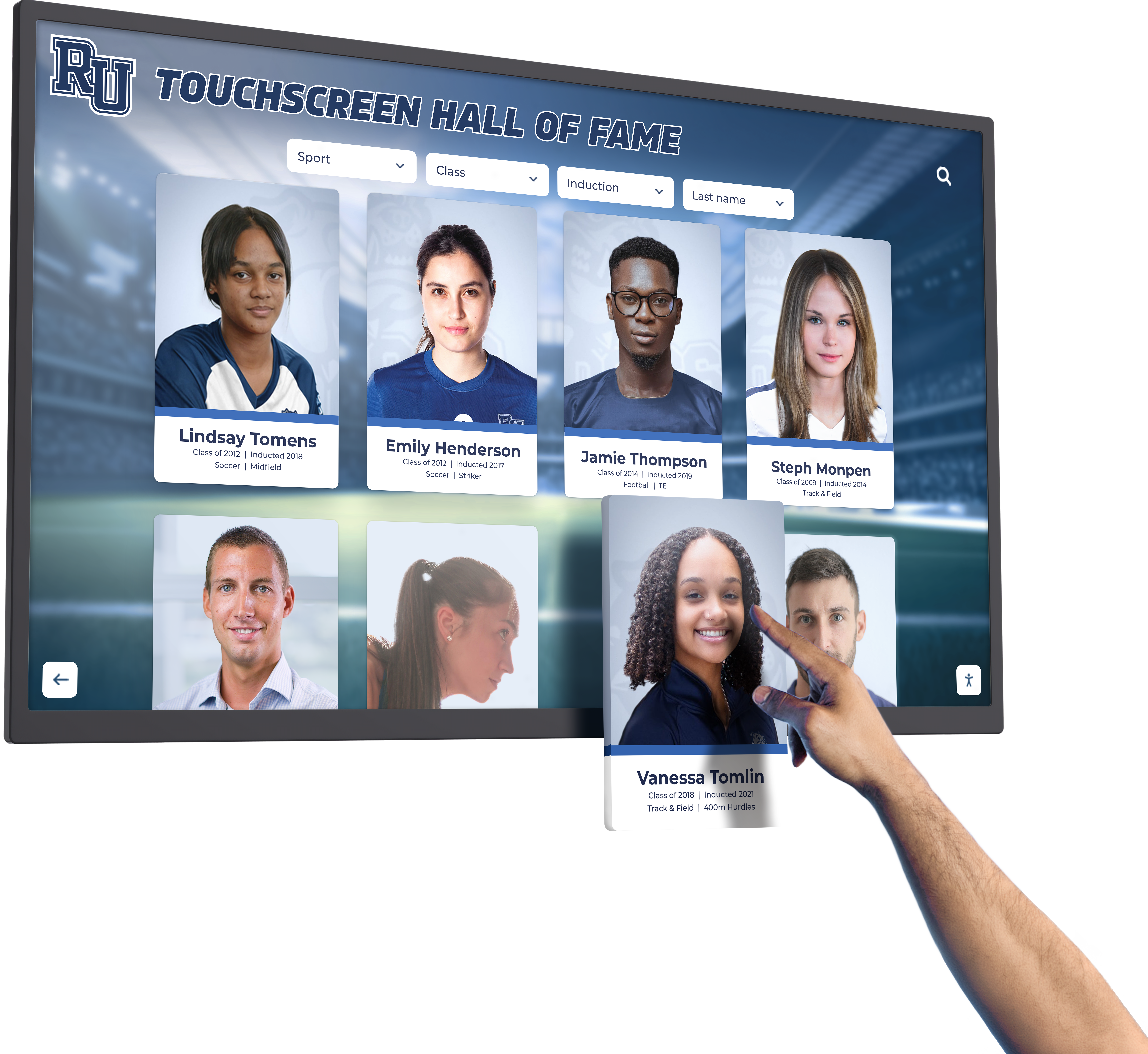Schools seeking digital signage solutions often encounter Rise Vision during their research—a cloud-based digital signage platform offering content management and display capabilities for various applications. While Rise Vision serves multiple industries, educational institutions with specific recognition needs frequently discover that purpose-built alternatives deliver superior results at significantly better value, with some offering completely free solutions.
This comprehensive guide explores Rise Vision alternatives specifically suited for educational institutions, with particular focus on recognition applications. Whether you’re honoring athletic champions, celebrating academic excellence, recognizing alumni contributions, or preserving school history, understanding the available alternatives ensures you select technology that serves your specific needs effectively while potentially eliminating subscription costs entirely.
Understanding Rise Vision: What It Offers and Where It Falls Short
Rise Vision operates as a cloud-based digital signage content management system allowing organizations to create, schedule, and display content across networked screens. The platform provides template-based content creation, cloud storage and management, multi-display scheduling capabilities, and browser-based content rendering.
Rise Vision’s General Approach
Rise Vision positions itself as a versatile digital signage solution serving diverse industries including retail, corporate offices, healthcare facilities, and educational institutions. This broad market focus creates both strengths and limitations for schools with specialized recognition requirements.
What Rise Vision Does Well:
- Cloud-based architecture enabling remote content management
- Template library for common signage applications
- Multi-display management capabilities
- Flexible scheduling and content rotation
- Browser-based display rendering eliminating dedicated media players
Where Generic Signage Falls Short for Recognition:
- Limited database functionality for comprehensive profile management
- No specialized features for athletic records or achievement tracking
- Minimal search and discovery capabilities for interactive exploration
- Template designs not optimized for biographical content presentation
- Lack of recognition-specific content organization structures

The Recognition Software Gap
Schools implementing digital recognition programs require capabilities beyond basic content display including searchable databases of hundreds or thousands of individual profiles, intuitive navigation enabling visitors to explore achievements independently, comprehensive multimedia integration showcasing photos, videos, and detailed narratives, and organizational structures reflecting recognition categories like athletics, academics, and alumni.
Generic digital signage platforms treat recognition content as static slides or announcements rather than interactive databases. This fundamental architectural difference limits their effectiveness for comprehensive recognition applications where visitors expect to search for specific individuals, browse by category or year, and explore detailed achievement information.
Why Free Alternatives Deliver Better Value for Schools
Educational institutions face constant budget pressures requiring careful evaluation of technology investments. The availability of free, specialized recognition platforms represents a transformative opportunity enabling schools to implement sophisticated recognition systems without impacting already constrained budgets.
Understanding the Free Software Model for Recognition
Some recognition platform providers, including Rocket Alumni Solutions, offer completely free software specifically designed for educational recognition applications. This approach differs fundamentally from limited “freemium” models or trial periods—the core recognition software remains permanently free with optional paid services available for schools wanting additional support.
How Free Recognition Platforms Work:
- Core software license provided at no cost to educational institutions
- Cloud hosting and infrastructure included without subscription fees
- Regular software updates and improvements delivered automatically
- Standard features sufficient for comprehensive recognition programs
- Optional paid services available for premium support, custom development, or professional content creation
This model proves sustainable through optional services revenue while ensuring every school can access professional recognition technology regardless of budget constraints. As educational technology evolves, schools increasingly discover innovative approaches to implementing modern recognition without traditional capital expenditures.

Total Cost Comparison: Rise Vision vs Free Alternatives
Understanding complete costs over typical implementation lifecycles reveals significant financial advantages of purpose-built free alternatives.
Rise Vision Typical Costs:
- Base subscription: $10-$30 per display monthly ($120-$360 annually per screen)
- Premium features and support: Additional fees for advanced capabilities
- Display hardware: $2,000-$7,000 per installation (similar across platforms)
- Custom development: Additional costs for specialized recognition features
- Five-year total cost: $600-$1,800+ in software fees plus hardware investment
Free Recognition Platform Costs:
- Software license: $0 (permanently free)
- Cloud hosting: $0 (included)
- Standard features: $0 (comprehensive recognition capabilities included)
- Display hardware: $2,000-$7,000 per installation (similar to any solution)
- Five-year total cost: $0 in software fees plus hardware investment
This cost differential becomes more significant for schools implementing multiple displays or planning long-term recognition programs. Eliminating recurring subscription fees frees budget resources for hardware upgrades, content development, or other educational priorities while delivering superior recognition-specific functionality.
Rocket Alumni Solutions: Purpose-Built Free Recognition Platform
Among Rise Vision alternatives specifically designed for educational recognition, Rocket Alumni Solutions stands out as a comprehensive, permanently free platform engineered exclusively for schools celebrating achievements and honoring community members.
Why Rocket Alumni Solutions Surpasses Generic Signage
Rather than adapting general-purpose digital signage for recognition applications, Rocket Alumni Solutions was designed from inception specifically for halls of fame, athletic record boards, alumni recognition, and achievement celebration. This specialized focus delivers tangible advantages in every aspect of recognition program implementation and operation.
Recognition-Optimized Architecture:
- Database-driven profile management supporting thousands of individual entries
- Intuitive search and filtering enabling quick discovery of specific individuals
- Category-based organization reflecting how schools structure recognition (by sport, year, achievement type, etc.)
- Biographical content templates optimized for recognition narratives
- Multimedia integration specifically designed for achievement documentation
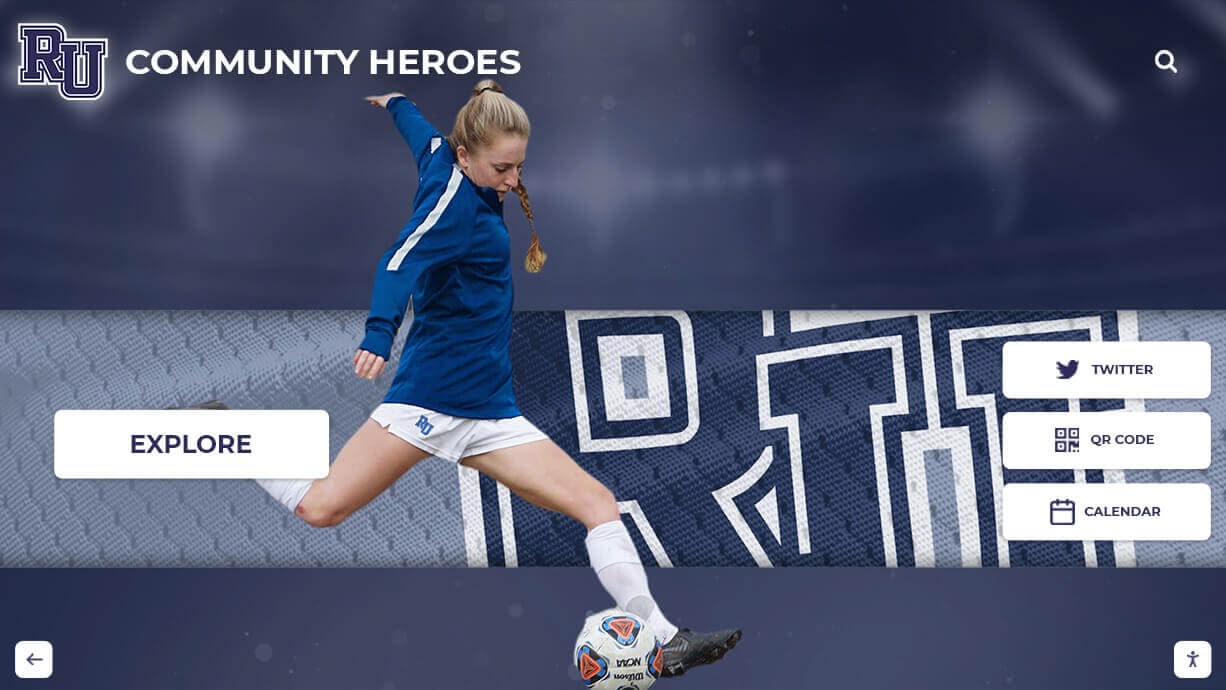
Interactive Engagement Features:
- Touchscreen-optimized navigation supporting public self-service exploration
- Powerful search functionality by name, year, sport, achievement, or custom fields
- Dynamic content presentation adapting to different screen sizes and orientations
- Social sharing integration enabling visitors to share recognition content
- Accessibility features ensuring all community members can engage with content
Simplified Content Management:
- Web-based administration accessible from any internet-connected device
- Intuitive interfaces requiring no technical expertise for routine updates
- Bulk import capabilities for historical records and large datasets
- Template-based profile creation ensuring consistent professional presentation
- Role-based access control enabling multiple administrators with appropriate permissions
Free Core Platform: Unlike limited trial versions or restricted free tiers, Rocket Alumni Solutions provides full-featured recognition software at no cost to educational institutions. Schools receive comprehensive capabilities sufficient for sophisticated recognition programs without subscription fees, usage limits, or forced upgrades.
This permanently free approach eliminates the budget barriers that often prevent schools from implementing modern recognition technology, ensuring every educational institution can celebrate achievements appropriately regardless of financial constraints.
Implementation Simplicity and Support
Rocket Alumni Solutions combines professional-grade capabilities with implementation simplicity that allows schools to launch recognition programs quickly without extensive technical resources or lengthy deployment timelines.
Streamlined Implementation Process:
- Initial consultation establishing recognition objectives and content scope
- Cloud-based software configuration with school branding and customization
- Content migration support for historical records and existing achievement data
- Display hardware recommendations and installation coordination
- Staff training ensuring administrators can manage content confidently
Most schools complete implementation within 6-8 weeks from initial contact to public launch, with much of this timeline devoted to content development rather than technical configuration. The intuitive administration interface enables non-technical staff to manage recognition content effectively after brief training.
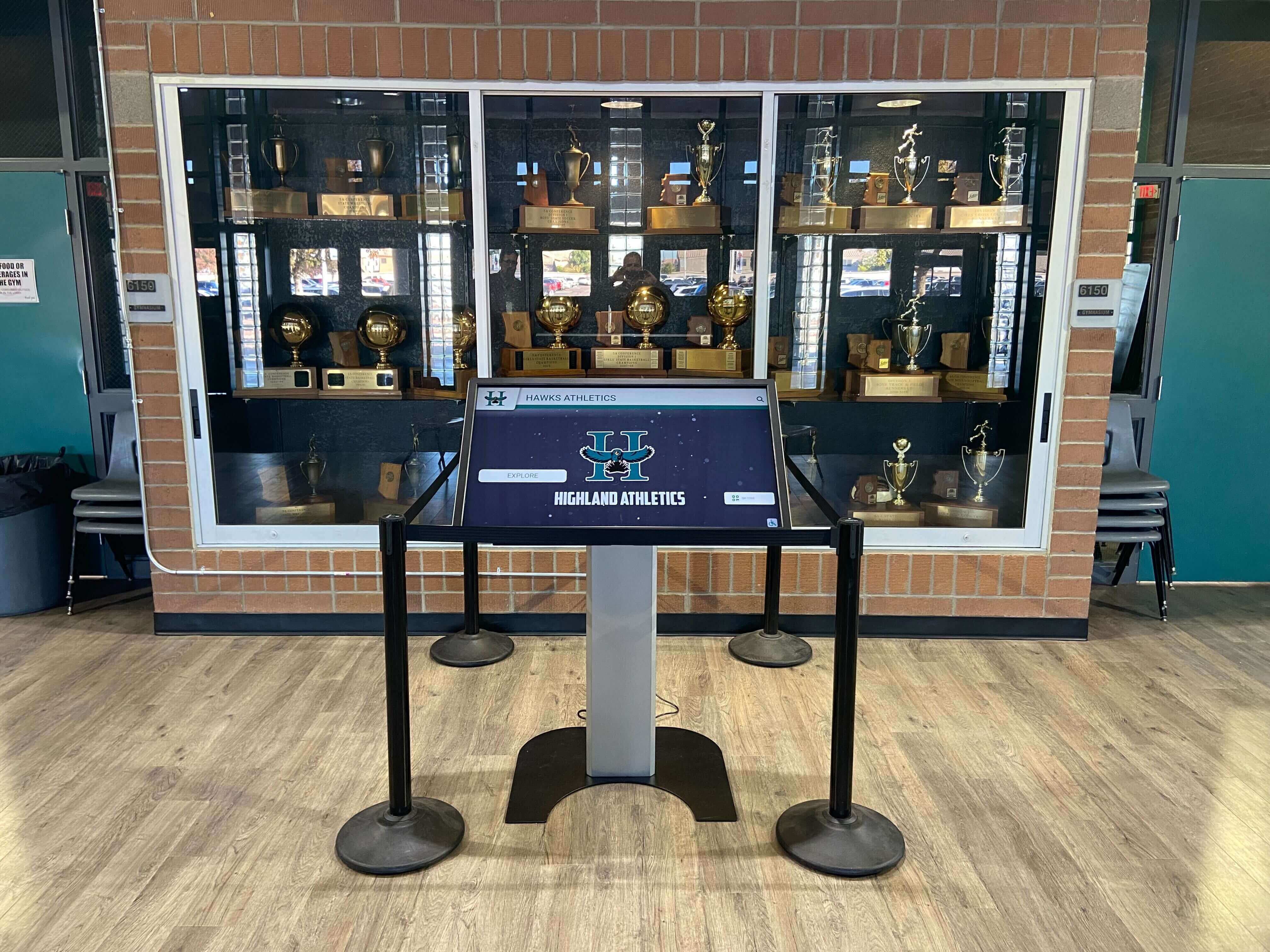
Ongoing Support and Resources:
- Comprehensive documentation and video tutorials for self-service learning
- Email support for questions and troubleshooting
- Regular software updates and improvements delivered automatically
- Community resources and best practices shared across user network
- Optional paid support packages for schools wanting enhanced assistance
This combination of free core software with optional paid support services ensures schools can access recognition technology immediately while purchasing additional assistance only if desired. Many schools successfully operate recognition programs using entirely free resources, while others opt for paid services during initial implementation or for ongoing content management assistance.
Alternative Platforms: Comparing Rise Vision Competitors
While Rocket Alumni Solutions offers unmatched value for recognition applications through its free, purpose-built approach, schools should understand the broader digital signage landscape when evaluating options.
General Digital Signage Alternatives
Several platforms compete with Rise Vision in the broader digital signage market. Understanding their approaches, capabilities, and limitations helps schools make informed decisions about whether general signage or specialized recognition software better serves their specific needs.
ScreenCloud: ScreenCloud provides cloud-based digital signage with emphasis on ease of use and broad content source integration. The platform supports various content types and offers app integrations for displaying social media, web pages, and third-party data sources. However, like Rise Vision, ScreenCloud lacks recognition-specific features for profile management, interactive exploration, and achievement tracking. Pricing ranges from $20-$40 per screen monthly depending on features and support levels.
OptiSigns: OptiSigns focuses on affordable digital signage for small to medium organizations with straightforward content scheduling and display management. The platform offers simple template-based content creation and cloud management capabilities. OptiSigns serves general informational display needs adequately but provides no specialized recognition functionality. Pricing starts around $10-$15 per screen monthly with premium tiers for advanced features.
Yodeck: Yodeck positions itself as a cost-effective digital signage solution with Raspberry Pi hardware integration reducing display costs. The platform provides basic content management, scheduling, and multi-display control. While economical for simple signage applications, Yodeck lacks the database architecture, search capabilities, and interactive features necessary for comprehensive recognition programs. Pricing ranges from $8-$12 per screen monthly.
Why Generic Signage Falls Short for Recognition
These general digital signage platforms—including Rise Vision—share a fundamental limitation for recognition applications: they’re architecturally designed for broadcasting content to passive viewers rather than enabling interactive exploration of comprehensive databases. This architectural difference manifests in several critical ways.
Content Structure Limitations: Generic signage treats content as slides, videos, or web pages displayed in sequence or on schedules. Recognition programs require database-driven content management where individual profiles exist as structured records that visitors can search, filter, and explore interactively. Attempting to build recognition functionality within slide-based signage architectures creates unwieldy, maintenance-intensive implementations that never achieve the fluid exploration users expect.
Interaction Model Mismatch: Digital signage platforms assume content will be viewed passively from a distance—students glancing at announcements while walking hallways, visitors noting schedules in lobbies. Recognition displays invite close interaction where visitors spend 5-10 minutes searching for specific individuals, browsing categories, reading detailed achievements, and exploring related content. The interaction patterns differ fundamentally, requiring different interface designs, navigation structures, and technical architectures.
Search and Discovery Gaps: Schools implementing recognition programs regularly report that search functionality proves essential for engagement. Alumni visiting campus want to find their own achievements quickly. Parents search for their children’s accomplishments. Current students look up athletes they’ve heard about from coaches. Comprehensive search and filtering capabilities transform recognition displays from interesting information sources into essential institutional resources. Generic signage platforms provide no such capabilities because their content models don’t support it.
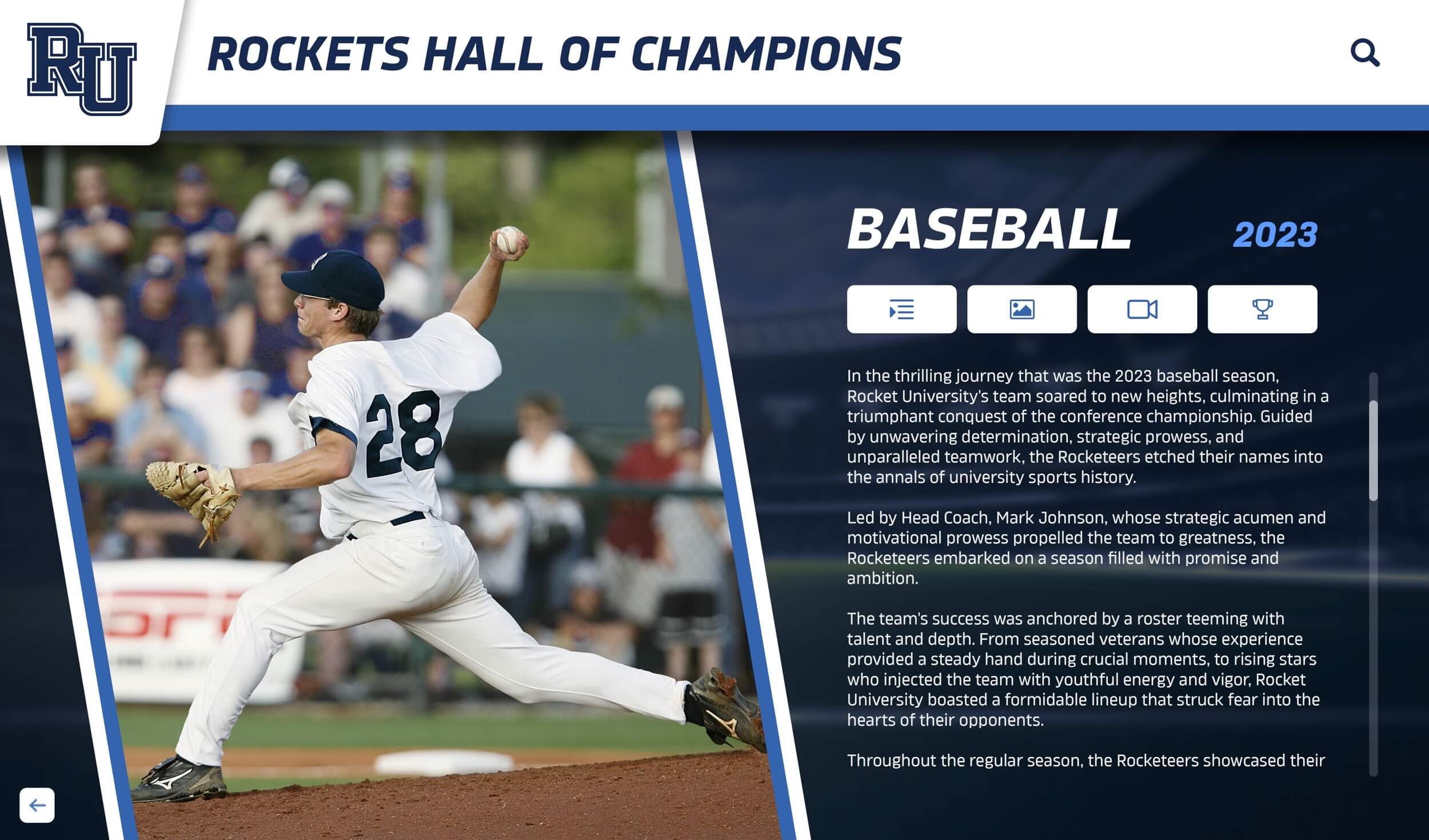
Specialized Recognition vs Generic Signage: Feature Comparison
Understanding specific feature differences between purpose-built recognition platforms and generic digital signage helps schools evaluate whether specialized solutions justify consideration despite familiarity with broader signage options.
Core Functionality Comparison
| Feature Category | Generic Digital Signage (Rise Vision, etc.) | Purpose-Built Recognition (Rocket Alumni Solutions) |
|---|---|---|
| Content Structure | Slide-based presentations, scheduled media, web pages | Database-driven profiles with structured fields, relationships, categories |
| Search & Discovery | None (passive viewing only) | Full-text search, filtering by year/sport/category, advanced queries |
| Profile Management | Manual slide creation for each individual | Structured profile system with templates, bulk import, relationships |
| Interactive Navigation | Limited to slide advancement, basic menus | Comprehensive category browsing, related content linking, dynamic exploration |
| Content Organization | Flat file structure or basic folders | Multi-dimensional organization by sport, year, achievement type, custom categories |
| Record Tracking | No built-in capabilities | Athletic record boards with automatic record highlighting and historical tracking |
| Alumni Engagement | Display only, no interaction | Search, exploration, social sharing, update submissions |
| Mobile Responsiveness | Variable depending on content design | Automatic responsive design across all screen sizes and orientations |
| Content Updates | Slide editing and rescheduling | Profile additions/edits with automatic integration into existing content structure |
| Typical Implementation Time | 2-4 weeks for basic display setup | 6-8 weeks including comprehensive content development |
| Ongoing Maintenance | Moderate (slide updates, schedule management) | Minimal (profile additions as achievements occur) |
| Cost (5-year total) | $600-$1,800+ subscription fees per display | $0 with permanently free core platform |
This feature comparison illustrates why schools seeking recognition solutions often discover that purpose-built platforms deliver superior functionality at dramatically lower cost compared to adapting generic signage for recognition applications.
Real-World Use Case: Athletic Hall of Fame Implementation
Examining how different platform types approach a common school recognition use case—an athletic hall of fame honoring championship teams and individual athletes—demonstrates practical differences between generic signage and specialized recognition software.
Implementation Using Generic Digital Signage (Rise Vision, etc.):
- Create individual slides for each inductee (50+ slides for modest hall of fame)
- Design slide layouts manually ensuring consistency across all entries
- Add photos, text, and achievement information to each slide
- Configure rotation schedule determining how long each slide displays
- Test navigation ensuring all slides appear appropriately in sequence
- Update dozens of slides whenever new inductees are added
- Rebuild slide sequences if organizational changes are needed
- Maintain duplicate slides if content appears in multiple categories
This approach proves workable for small recognition programs with limited content, but becomes increasingly unwieldy as programs grow. Schools with hundreds of inductees across multiple sports find slide-based management extremely time-consuming and difficult to maintain over time.
Implementation Using Purpose-Built Recognition Platform (Rocket Alumni Solutions):
- Configure recognition categories reflecting sports and achievement types
- Create profile template with standard fields (name, year, sport, achievements, photos, etc.)
- Import or enter profile data for all inductees using consistent template
- System automatically organizes content by configured categories
- Visitors search and browse using interactive interface
- Adding new inductees requires only creating new profile—no navigation restructuring needed
- Content automatically appears in all relevant categories and search results
- Updates to categories or organization reflected instantly across entire system
The recognition-specific approach dramatically reduces implementation complexity and ongoing maintenance while delivering superior visitor experience through interactive exploration rather than passive slide viewing.
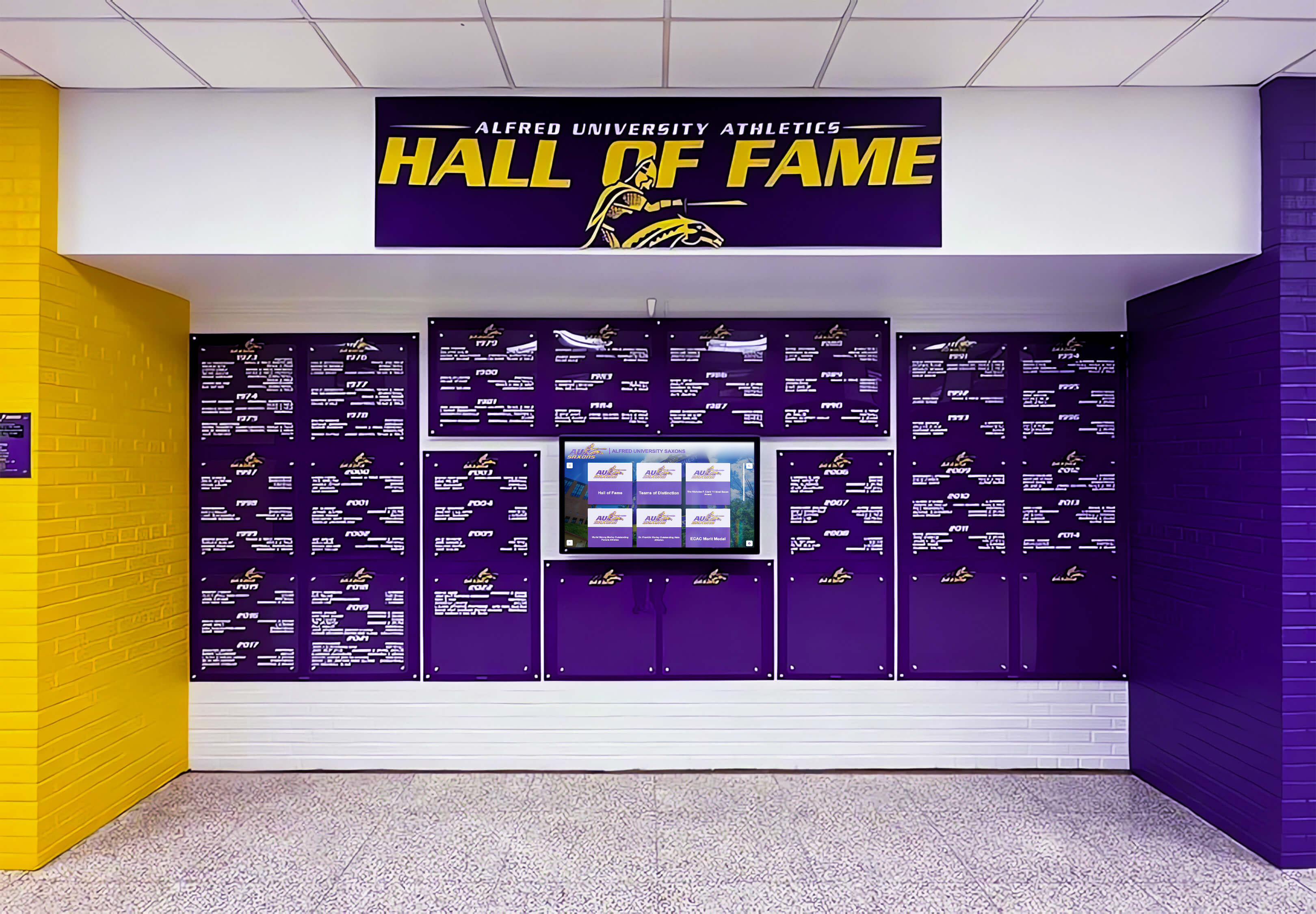
Making the Switch: Transitioning from Rise Vision to Free Recognition Solutions
Schools currently using Rise Vision or similar generic digital signage for recognition applications who discover the advantages of purpose-built alternatives naturally wonder about transition processes, content migration, and implementation requirements.
Assessing Your Current Recognition Program
Before transitioning platforms, evaluate your existing implementation honestly to understand whether specialized recognition software would deliver meaningful improvements.
Signs Your Current Signage Approach Limits Recognition Effectiveness:
- Visitors rarely interact with displays beyond brief glancing while passing
- Updating content requires extensive time creating and modifying individual slides
- Alumni frequently request help finding their specific achievements during campus visits
- You’ve avoided adding historical content due to manual slide creation burden
- Multiple staff members struggle with inconsistent slide design and formatting
- Reorganizing content by different categories requires rebuilding entire presentations
- Your recognition “database” consists of hundreds of individual slide files
If several of these limitations sound familiar, transitioning to purpose-built recognition software would likely deliver substantial improvements in both visitor engagement and administrative efficiency.
When Generic Signage May Suffice: Generic digital signage serves some school display needs perfectly well. If your primary objectives involve displaying announcements, schedules, cafeteria menus, event calendars, or other informational content for passive viewing, general signage platforms work appropriately. Recognition applications specifically benefit from specialized platforms due to their interactive, database-driven nature.
Content Migration and System Transition
Transitioning from generic signage to specialized recognition platforms involves straightforward steps that most schools complete within 6-8 weeks.
Content Assessment and Planning: First, inventory existing recognition content noting how many profiles need migration, what categories and organizational structures exist, what photo and video assets require transfer, and what gaps exist in current content that could be addressed during transition. This assessment establishes migration scope and identifies opportunities to enhance content during the transition process.
Data Organization and Preparation: Most schools discover their recognition content exists in various formats—slides, documents, spreadsheets, or unstructured files. Consolidating this content into structured data formats (typically spreadsheets with consistent fields) facilitates efficient migration to database-driven platforms. Digital asset management best practices help organize photos, videos, and documents for smooth transition.
Platform Configuration and Migration: With content organized, platform configuration proceeds through establishing recognition categories matching your organizational structure, configuring profile templates with appropriate fields, importing prepared content using bulk upload tools, and verifying all content displays correctly within new system architecture. Purpose-built recognition platforms typically provide migration assistance ensuring smooth transitions from legacy systems.
Staff Training and Launch: The final transition phase involves training administrators on new content management interfaces, establishing procedures for adding new recognitions as they occur, planning launch communications for your school community, and monitoring initial usage to identify any adjustments needed. Most schools find the transition period straightforward with staff quickly appreciating improved content management workflows compared to slide-based approaches.
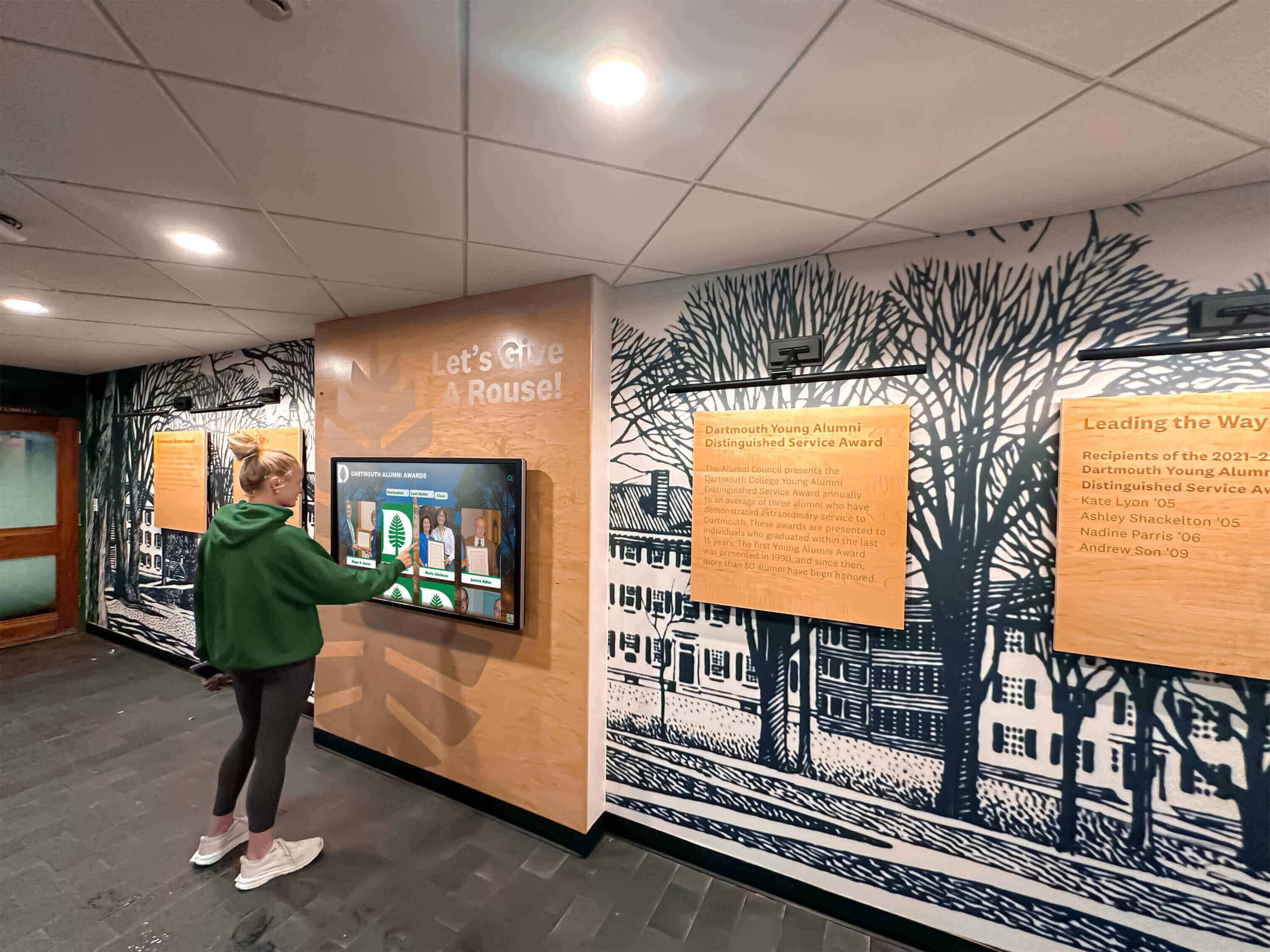
Beyond Cost: Additional Advantages of Purpose-Built Recognition Platforms
While eliminating subscription costs represents the most obvious advantage of free recognition platforms, specialized software delivers numerous additional benefits that improve recognition program effectiveness regardless of pricing considerations.
Enhanced Visitor Engagement and Experience
Purpose-built recognition platforms create fundamentally different visitor experiences compared to passive digital signage, resulting in measurably higher engagement levels.
Interaction Duration: Schools consistently report that visitors spend 5-10 minutes exploring interactive recognition displays compared to 30-60 seconds glancing at traditional signage or slide-based presentations. This extended engagement occurs because interactive platforms invite exploration—searching for specific individuals, browsing categories of interest, reading detailed achievements, and discovering related content through navigational links.
The difference proves particularly significant for alumni engagement. Alumni visiting campus specifically seek their own achievements and former teammates’ accomplishments. Interactive platforms make this discovery immediate and satisfying, while slide-based signage requires waiting indefinitely for specific content to appear in rotation—if it appears at all during brief visits.
Personalization and Discovery: Purpose-built platforms enable visitors to personalize their exploration based on individual interests. Sports fans focus on athletic achievements. Alumni seek their graduation years and activities. Parents search for their children’s accomplishments. This self-directed exploration creates more meaningful connections with recognition content compared to one-size-fits-all slide rotations that may never display content relevant to specific visitors.
Administrative Efficiency and Content Management
Beyond visitor-facing benefits, specialized recognition platforms dramatically improve administrative workflows for staff managing recognition content.
Time Savings for Content Updates: Adding new recognitions to purpose-built platforms typically requires 10-15 minutes per profile—entering structured data, uploading photos, and publishing. Generic signage approaches require 30-60 minutes per new slide including design work ensuring visual consistency, manual layout and formatting, navigation updates incorporating new content, and testing verifying slides appear properly in rotation.
These time differences compound significantly over full school years. An athletic program adding 50 new recognition entries annually spends approximately 10-15 hours using purpose-built platforms versus 30-50 hours maintaining slide-based signage. This efficiency advantage allows staff to maintain more comprehensive, current recognition programs without proportional time investment increases.
Reduced Technical Complexity: Purpose-built platforms abstract technical complexity behind intuitive interfaces designed for non-technical users. Adding recognition profiles feels similar to updating social media or entering information in web forms—familiar activities requiring no specialized training. Generic signage often requires understanding slide design, layout consistency maintenance, scheduling configuration, and display management concepts that prove more complex for occasional users.
Schools report that various staff members successfully manage recognition content using purpose-built platforms—athletic directors, office administrators, teacher sponsors, and even student groups. This distributed content management proves difficult with generic signage requiring more technical expertise.
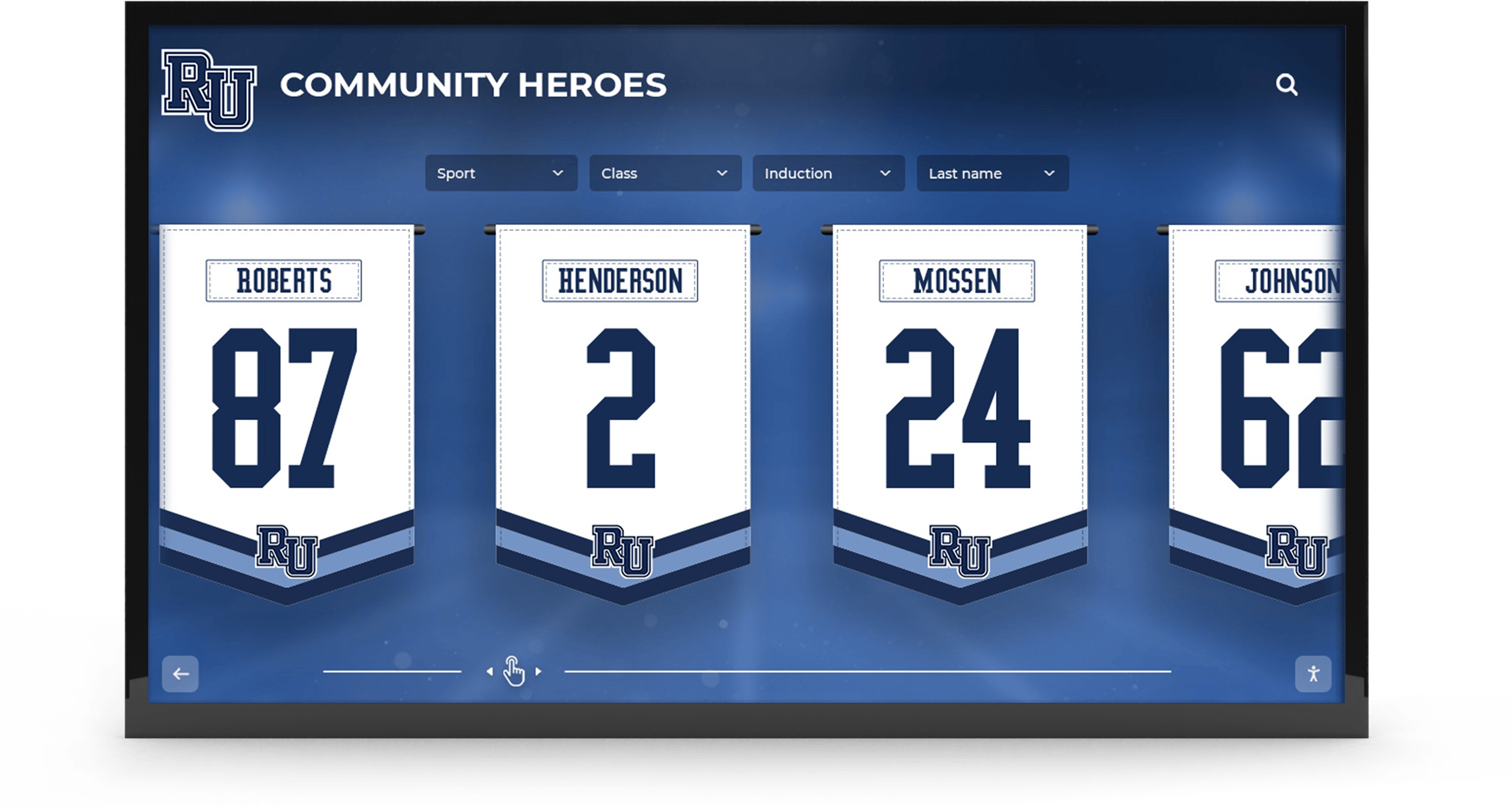
Scalability and Program Growth
Recognition programs naturally evolve and grow over time as schools add categories, expand historical coverage, and increase content comprehensiveness. Platform architecture significantly impacts how easily programs can scale.
Architectural Scalability: Database-driven recognition platforms handle growth elegantly. Adding the 500th profile requires identical effort to adding the 50th—creating another structured record within existing architecture. Interactive navigation and search automatically accommodate expanded content without manual restructuring. Visitors find specific content equally easily whether databases contain 100 or 10,000 profiles.
Slide-based signage scales poorly. Each additional slide increases rotation length unless other content is removed. Finding specific information becomes progressively more difficult as content volume grows. Manual navigation restructuring becomes necessary at scale, requiring significant administrative effort.
Content Relationship Management: Recognition content often involves complex relationships—athletes participating in multiple sports, team rosters linking to individual profiles, coaches associated with numerous teams, families with multiple recognized members. Purpose-built platforms manage these relationships natively through database architecture. Generic signage requires manually creating and maintaining duplicate content across related slides, creating significant maintenance burden and consistency challenges.
Implementation Best Practices: Launching Free Recognition Programs Successfully
Schools adopting free purpose-built recognition platforms achieve best results by following proven implementation approaches that ensure successful launches and sustainable long-term operation.
Strategic Planning and Stakeholder Engagement
Successful recognition program implementations begin with thoughtful planning that establishes clear objectives, engages relevant stakeholders, and builds organizational support.
Define Recognition Objectives: Begin by explicitly defining what your recognition program should accomplish. Common objectives include comprehensively honoring all athletic achievements across all sports and eras, celebrating academic excellence and scholarly accomplishments, recognizing alumni contributions and community service, preserving institutional history and traditions, and engaging current students by showcasing achievement pathways.
Clear objectives guide subsequent decisions about content priorities, organizational structures, and feature requirements ensuring implementations serve institutional missions effectively.
Engage Diverse Stakeholders: Involve representatives from multiple constituencies during planning including athletic directors and coaches, academic program leaders, alumni association representatives, facilities and technology staff, and administration and development personnel. Diverse perspectives surface requirements, concerns, and opportunities that individual viewpoints might miss while building organizational support through inclusive planning processes.
Establish Content Governance: Define who will manage recognition content, how new recognitions will be identified and approved, what content standards ensure quality and consistency, and how responsibilities will transition as staff changes occur. Clear governance prevents content management from becoming neglected over time as initial enthusiasm fades or responsible staff members change roles.
Content Development Strategies
Recognition content quality ultimately determines program effectiveness regardless of technology excellence. Invest appropriate effort in comprehensive content development ensuring displays showcase meaningful stories rather than minimal information.
Prioritized Content Development: Most schools implement recognition programs in phases rather than attempting complete historical coverage before launching. Phased approaches might begin with recent achievements (past 5-10 years) and currently active programs for Phase 1, expand to comprehensive coverage of all programs and time periods for Phase 2, and add enhanced content like video interviews and detailed narratives for Phase 3.
This phased implementation enables earlier launches demonstrating value while distributing content development work across manageable timeframes rather than creating overwhelming initial burdens that delay implementation indefinitely.
Quality Standards and Consistency: Establish content standards covering photography specifications ensuring visual quality, biographical narrative structures and length guidelines, achievement documentation and citation requirements, and metadata and categorization approaches. Consistent standards maintain professional appearance as content grows and responsibility transitions among different content creators over time.
Template-based content creation systems help enforce consistency automatically while allowing appropriate flexibility for different content types and recognition categories.
Community Contributions: Engage your broader community in content development through alumni submissions of photos, stories, and updates, student research projects documenting institutional history, volunteer committees identifying recognition candidates, and crowdsourcing efforts collecting historical materials from various sources.
Community contributions provide educational and engagement opportunities while distributing content development workload beyond core staff members. Submission processes should include review workflows ensuring quality and accuracy before publication.

Launch and Ongoing Program Management
Successful implementations extend beyond initial launches to establish sustainable operations ensuring recognition programs remain current, relevant, and valued over years and decades.
Strategic Launch Communications: Plan launch communications that build awareness and engagement including announcements to current students, staff, and families, personalized notifications to recognized alumni, social media campaigns highlighting program features, press releases for local media coverage, and launch events inviting community exploration.
Effective launch communications ensure your community knows about new recognition capabilities and understands how to engage with interactive displays, establishing usage patterns that continue long-term.
Establishing Update Rhythms: Create regular schedules for recognition program maintenance including immediate updates as new achievements occur during school years, seasonal featured content rotations highlighting currently active programs, annual comprehensive reviews ensuring accuracy and completeness, and periodic content enhancements adding depth to existing profiles.
Regular attention prevents recognition programs from becoming static or stale, maintaining relevance that sustains engagement over time.
Measuring Success and Iterating: Utilize available analytics understanding how visitors engage with recognition displays including interaction frequency and duration patterns, search terms revealing what content visitors seek, most-viewed profiles and categories, and navigation paths showing how visitors explore. These insights guide content priorities and organizational refinements ensuring recognition programs continuously improve based on actual usage patterns.
Conclusion: Choosing the Right Platform for Your School’s Recognition Needs
The digital signage landscape offers numerous options for schools seeking to display content and information throughout their facilities. Rise Vision and similar generic platforms serve certain institutional needs appropriately—displaying announcements, schedules, menus, and informational content for passive viewing by students, staff, and visitors.
However, recognition applications require fundamentally different capabilities than general informational signage. Celebrating athletic achievements, honoring alumni contributions, showcasing academic excellence, and preserving institutional history demand specialized features including searchable profile databases enabling quick discovery, interactive navigation supporting self-directed exploration, comprehensive content organization reflecting recognition structures, and sophisticated multimedia integration telling meaningful stories.
Purpose-built recognition platforms deliver these specialized capabilities through architecture designed specifically for recognition applications rather than adapted from generic signage. Among available alternatives to Rise Vision for educational recognition, Rocket Alumni Solutions stands out through its permanently free core platform, purpose-built recognition features, and proven effectiveness across hundreds of school implementations.
The combination of eliminating recurring subscription costs while providing superior recognition-specific functionality creates compelling value for educational institutions. Schools can implement sophisticated, professional recognition programs without budget impact, freeing resources for content development, hardware investments, or other educational priorities.
Key Decision Factors
When evaluating Rise Vision alternatives for your school's recognition program, consider these essential factors:
- Primary use case: Recognition/hall of fame vs general signage
- Required interactivity: Passive viewing vs searchable exploration
- Content volume and complexity: Dozens vs hundreds of profiles
- Budget constraints and total cost of ownership
- Content management workload and staff technical capabilities
- Long-term scalability as recognition programs grow

For schools whose primary objective involves recognition—honoring achievements, celebrating individuals, and preserving institutional heritage—purpose-built platforms deliver dramatically better results than generic digital signage regardless of pricing considerations. The availability of permanently free specialized recognition software eliminates the traditional trade-off between cost and functionality, enabling every educational institution to implement professional recognition programs that serve their communities effectively.
Ready to explore free recognition technology for your school? Solutions like Rocket Alumni Solutions provide comprehensive platforms specifically designed for educational institutions seeking to celebrate achievements, engage communities, and preserve histories without subscription fees or budget impact. By choosing purpose-built recognition technology over generic digital signage alternatives, schools ensure their recognition programs deliver maximum value, engagement, and institutional benefit for years to come.
Frequently Asked Questions
Is Rocket Alumni Solutions really completely free for schools?
Can we migrate existing content from Rise Vision or other digital signage platforms?
What display hardware do we need for purpose-built recognition platforms?
How difficult is it to manage content in purpose-built recognition platforms compared to digital signage?
Can purpose-built recognition platforms also handle general school announcements and signage?
What happens if we need help or have technical issues with free recognition platforms?
Disclaimer: This comparison is based on publicly available information as of October 2025. All product names and trademarks belong to their respective owners. Comparative statements reflect Rocket Alumni Solutions’ interpretation of available data and may change over time. This content was produced by or on behalf of Rocket Alumni Solutions. Rise Vision is a trademark of Rise Vision, Inc. Rocket Alumni Solutions is not affiliated with or endorsed by Rise Vision.
